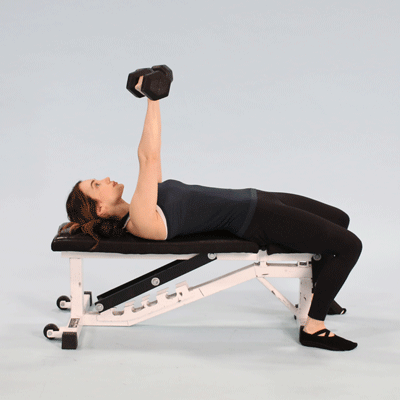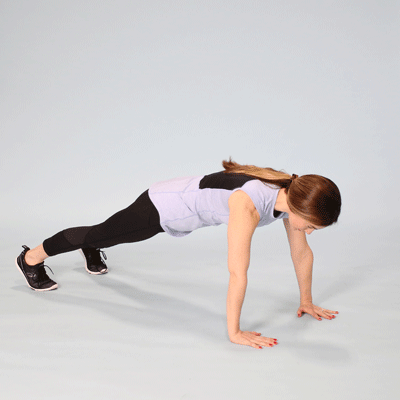The bench press is one of the best-known exercises for developing a killer chest — aka the bench is probably one of the most popular pieces of equipment at your gym.
No need to fret! If you can’t seem to get on a bench, or if you don’t have access to a barbell and plates, there are plenty of other exercises to try that will provide many of the same benefits.
Below, we’ve curated 12 bench press alternatives to build your pectoral muscles.
Pick two to three of the following moves to incorporate into your workout twice a week and watch that upper body grow.
With each exercise, you’ll want to complete 3 sets of 12 reps.
This should be challenging enough that you can complete the last rep with good form, but you couldn’t complete another.
Ensure that you’re adding weight to consistently challenge yourself — this is called progressive overload.
Dumbbells can be easier to locate — and handle — than a barbell, especially for a beginner.
Another bonus: The dumbbell chest press targets the same muscles as the bench press: the pectorals, anterior deltoid, and triceps.
How to do it
- Lie with your back on a bench and a dumbbell in each hand, resting at chest level.
- Face your palms toward your feet, and ensure that your feet are flat on the floor.
- Begin to extend your arms and push the dumbbells up over your chest. Your arms should be directly over your shoulders at the top.
- Once your arms are straight, pause and release the weights back down to shoulder level.
- You’ll notice an increased range of motion with dumbbells than with a barbell. Push back up again.
Complete 3 sets of 12 reps.
Requiring no equipment, the pushup can be performed anywhere.
But don’t let that fool you — it still targets your chest in a big way, plus many other muscles throughout the entire body.
If a standard pushup is too challenging, start on your knees.
How to do it
- Assume a high plank position with your hands slightly wider than your shoulders.
- Your head should be positioned so that you’re looking just ahead, and your body should form a straight line from head to toe.
- Begin to bend your elbows, which should be at a 45-degree angle, and lower down until your chest touches the ground.
- Push back up to start.
Aim for 3 sets of 12 reps. If you’re starting on your knees, aim for a set of 20 reps. Once this becomes easy, come up to your feet.
A variation on a dumbbell chest press, the incline dumbbell press targets the upper portion of the pectoral muscle and shoulders more than a standard bench press does.
How to do it
- Adjust your bench so it’s set at a 45-degree angle.
- Hold a dumbbell in each hand and place your back flat against the bench.
- Your feet should be flat on the floor.
- Bring your dumbbells to shoulder level, palms pointed out.
- Extend your elbows, pushing the dumbbells up overhead.
- Release the dumbbell, bringing them to the sides of your chest, then push back up.
Complete 3 sets of 12 reps.
Whereas the incline dumbbell press targets the upper pecs, the decline dumbbell press targets the lower pecs.
How to do it
- Adjust the bench so it’s at a slight decline.
- Hold a dumbbell in each hand and lie back on the bench, holding the dumbbells at shoulder level.
- Extend your elbows, pushing the dumbbells up.
- Release them, letting them come back down to shoulder level, then push them back up again.
Complete 3 sets of 12 reps.
While the dumbbell fly targets the chest, it also recruits the shoulders and upper back in a bigger way.
You won’t be able to go as heavy with a dumbbell fly, so choose light- to moderate-weight dumbbells to start.
How to do it
- Hold a dumbbell in each hand, and lie with your back flat on the bench.
- Place your feet flat on the floor.
- Extend your arms and bring the dumbbells up over the center of your chest. They should be parallel to your body.
- Slowly begin to drop your arms down to each side, keeping a slight bend in the elbow.
- Stop when the dumbbells are at shoulder level.
- Using your chest muscles, pull the dumbbells back up to center.
Complete 3 sets of 12 reps.
Using just your body weight, bench dips promote upper body strength.
They target the triceps, chest, and shoulders — just as a bench press would — plus the lats.
How to do it
- Sit down on a bench, hands next to your thighs.
- Walk your feet out and extend your legs, lifting your bottom off the bench and holding there with extended arms.
- You also have the option here to leave your knees bent if you need extra support.
- Hinging at the elbow, lower your body down as far as you can go, or until your arms hit 90 degrees.
- Push up through your palms back to start.
Complete 3 sets of 12 reps.
A floor press is basically a bench press on the ground, so it works the same muscles.
Because you can feel your shoulder and back engagement with your upper body flat across the floor, it’s a great exercise to protect your shoulders.
How to do it
- Lie with your back flat on the ground and your legs extended, holding a barbell across your chest. Your palms should face out.
- Push the barbell up by extending your arms.
- Pause at the top, then lower the weight until your arms touch the ground.
- Explode back up for another rep.
Complete 3 sets of 12 reps.
Requiring an extra layer of stability by standing, the cable chest press targets the same muscles as a bench press and challenges you even further.
How to do it
- Position two cables slightly below chest level. Face away from the machine, and grab the handles with an overhand grip and bent elbows.
- Stagger your stance, lean forward, and push the handles out and toward the middle of your chest.
- Pause here, then release the cables until the handles are at chest level.
- Then push back out.
Complete 3 sets of 12 reps.
Targeting the chest in a slightly different way, the dumbbell pullover also requires the stabilizer muscles and core to work in overdrive.
How to do it
- Holding the dumbbell with both hands, position yourself on the ball or bench so that your upper back is supported on the surface.
- Your knees should be bent at a 90-degree angle.
- Extend your arms over your head so they’re parallel with the ground.
- Keeping your arms extended and core engaged, pull the dumbbell up and over your head.
- When your arms reach perpendicular to the ground, lower them back to start.
Complete 3 sets of 12 reps.
Doing a pushup with one hand on an elevated surface requires your shoulders, chest, and core to work in a different way to stabilize your body.
Your range of motion is also increased.
How to do it
- Assume a high plank position with one hand on a step or Bosu ball.
- Complete a pushup with your elbows positioned at a 45-degree angle, keeping your body in a straight line from head to heel.
- Step your hands up together at the center of the step or ball and over, switching sides.
Complete 3 sets of 12 reps.
Another exercise that targets the lower portion of the pecs, the cable crossover requires extra stability and core strength because you’re standing.
How to do it
- Position two cables at the top rung.
- Grab the handles with an overhand grip and palms facing your body. Face away from the machine.
- Stagger your stance, lean forward, and, with a slight bend in the elbow, begin to pull your hands together.
- Stop when they touch.
- Release the weight, allowing your arms to come up past your shoulders, then pull them together again.
Complete 3 sets of 12 reps.
Machines provide more stability than free weights, making them a great option for beginners.
The chest press machine works the same muscles as a bench press, too.
How to do it
- Sit on the machine, back flat against the pad.
- Grip the handles with your palms facing out.
- Push the weight away from your body, keeping your feet on the floor.
- Once your arms are straight, pause and return to start.
Complete 3 sets of 12 reps.
Mixing things up may provide more gains than you think! Challenge your muscles in a different way, and say goodbye to your days of waiting for a bench press.
Nicole Davis is a writer based in Madison, WI, a personal trainer, and a group fitness instructor whose goal is to help women live stronger, healthier, happier lives. When she’s not working out with her husband or chasing around her young daughter, she’s watching crime TV shows or making sourdough bread from scratch. Find her on Instagram for fitness tidbits, #momlife and more.


